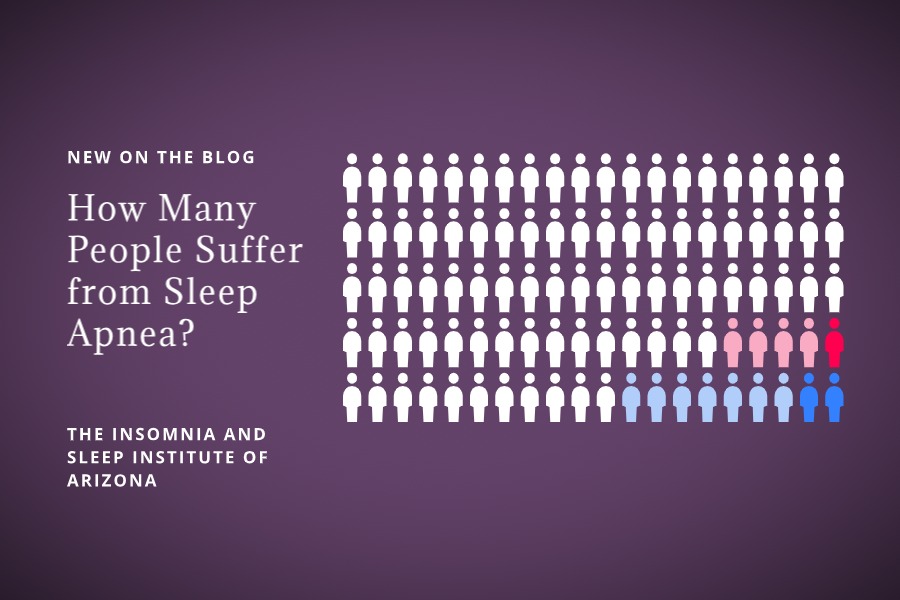Obstructive sleep apnea (OSA) is a sleep disorder characterized by repeated episodes of breathing cessation during sleep, typically caused by the relaxation of throat muscles, leading to temporary airway blockages. It is by far the most common form of sleep apnea. OSA is diagnosed by the number of times you experience reduced (hypopnea) or full cessation of breathing (apnea) during one hour of sleep. If you have more than five such episodes in an average hour of sleep, you have OSA. If you experience more than 30 such episodes, you have severe OSA. To be diagnosed with OSA syndrome, you must experience at least 5 hypopnea/apnea episodes in an hour and also complain of excessive daytime sleepiness.
Approximately 40 million people in the U.S. suffer from sleep apnea
Most sleep apnea studies have shown OSA to occur in around 20% of men and 10% of women [1,2]. Around 4% of men and 2% of women suffer from OSA syndrome, meaning they have sleep apnea and complain of excessive daytime sleepiness. These studies are, on average around 20 years old. Because obesity has increased during the last 20 years, we would expect that the rate of sleep apnea has also increased during this period and may be higher now. If we conservatively say that 15% of all adults in the U.S. have sleep apnea, that’s 38.7 million people! (258 million adults in the U.S., according to the 2020 census).
Sleep apnea is not evenly distributed across the population. Some people are more likely to suffer from sleep apnea than others:
1. Men are more likely to suffer from sleep apnea
About twice as many males as females have sleep apnea[2]. The same thing goes for differences in snoring. Men tend to snore about twice as much. With men, the neck is larger and heavier, carrying more muscle and fat, which can restrict air flow when resting.
2. Heavier body weight is linked to sleep apnea
Researchers and physicians have long recognized the link between obesity and sleep apnea. A 5.3 pt increase in body-mass index (BMI) is associated with a 55% higher chance of suffering from sleep apnea[1]. This is the equivalent of gaining about 12 pounds.
3. Neck girth is linked to sleep apnea
Each 1.7-inch increment in neck girth makes one 42% more likely to suffer from sleep apnea [1]. This is because increased fat, muscle, and other tissues add weight to the throat and they make the airway smaller, both of which contribute to sleep apnea. This is a major reason why losing weight is so helpful to those suffering from sleep apnea.
4. Snoring can be indicative of sleep apnea
Moderate snoring less than three nights per week does not predict sleep apnea, but habitual, loud snoring does indicate a higher likelihood of obstructive sleep apnea. Habitual snorers who snore three to seven nights a week are 75% more likely to have sleep apnea. Those who snore “somewhat loudly” are 42% more likely to have sleep apnea, and those who snore “extremely loudly” are 121% more likely than others to have sleep apnea.[1]
Conclusion
Roughly 15% of adults suffer from obstructive sleep apnea, and 3% suffer from sleep apnea plus excessive daytime sleepiness. A variety of risk factors can increase one’s odds of having the problem, including body weight, neck girth, and male gender. Because of the effects of sleep apnea on overall health and productivity, this is an important issue heavily impacting our society.
References
- Franklin, Karl A., and Eva Lindberg. “Obstructive sleep apnea is a common disorder in the population—a review on the epidemiology of sleep apnea.” Journal of thoracic disease 7, no. 8 (2015): 1311.
- Kapur, Vishesh K. “Obstructive sleep apnea: diagnosis, epidemiology, and economics.” Respiratory care 55, no. 9 (2010): 1155-1167.





